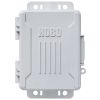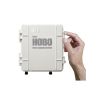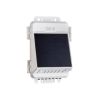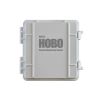HOBO ECH2O EC-5 Soil Moisture Smart Sensor
Features
- Measures a 0.3-liter volume of soil
- High-frequency (70 MHz) circuit provides good accuracy even in high-salinity and sandy soils
- Compatible with Onset stand-alone and web-based weather stations
- Free ground shipping
- Expedited repair and warranty service
- Lifetime technical support
- More
Overview
The Onsite ECH2O EC-5 soil moisture smart sensor offers a two-tine design for easy installation in in an affordable package. This sensor integrates the field-proven ECH2O EC-5 Sensor and a 12-bit A/D. It provides ±3% accuracy in typical soil conditions, and ±2% accuracy with soil-specific calibration. Readings are provided directly in volumetric water content. This sensor is designed to maintain low sensitivity to salinity and textural effects.
Measurement Range
In soil: 0 to 0.550(m³/m³)
Extended range: -0.401 to 2.574 m³/m³ (full scale)
The sensor is capable of providing readings outside the standard volumetric water content range. This is helpful in diagnosing sensor operation and installation. See User Manual for additional information.
Accuracy: ±0.031 m³/m³ (±3.1%) typical 0 to 50°C (32° to 122°F); ±0.020 m³/m³ (±2%) with soil specific calibration.
This is a system-level accuracy specification and is comprised of the ECH2O probe's accuracy of ±0.03 m³/m³ typical (±0.02 m³/m³ soil specific) plus the smart sensor adapter accuracy of ±0.001 m³/m³ at 25°C (77°F). There are additional temperature accuracy deviations of ±0.003 m³/m³ / °C maximum for the ECH2O probe across operating temperature environment, typical <0.001 m³/m³ / °C. (The temperature dependence of the smart sensor adapter is negligible.)
Resolution: 0.0007 m³/m³ (0.07%)
Soil probe dimensions: 89 x 15 x 1.5 mm (3.5 x 0.62 x 0.06 in.)
Weight: 180 grams (6.3 oz)
Decagon ECH2O probe part No.: EC-5
Sensor operating temperature: 0° to 50°C (32° to 122°F).
While the sensor probe and cable can safely operate at below-freezing temperatures (to -40°C/F) and up to 75°C (167°F), the soil moisture data collected at these extreme temperatures is outside of the sensor's accurate measurement range.
Volume of influence: 0.3 liter (10.1 oz)
Sensor frequency: 70 MHz
Bits per sample: 12
Number of data channels: 1
Note: A single smart sensor-compatible HOBO logger can accommodate 15 data channels and up to 100 m (328 ft) of smart sensor cable (the digital communications portion of the sensor cables)
Measurement averaging option: No
Cable length available: 5 m (16 ft)
Length of Smart Sensor network cable: 0.5 m (1.6 ft)
In The News
From Paddles to Phytoplankton: Studying Vermont’s Wildest Lakes
For six months of the year, Rachel Cray, a third-year PhD student at the Vermont Limnology Laboratory at the University of Vermont, lives between a microscope and her laptop, running data. For the other six months, she is hiking and canoeing four of Vermont’s lakes, collecting bi-weekly water samples. Cray studies algal phenology across four lakes in Vermont, US, that have low anthropogenic stress—or in other words, are very remote. Funded by the National Science Foundation Career Award to Dr. Mindy Morales, the lakes Cray researches part of the Vermont Sentinel Lakes Program, which studies 13 lakes in the area and, in turn, feeds into the Regional Monitoring Network, which operates in the Northeast and Midwest US.
Read MoreReimagining Water Filtration: How Monitoring and Science Enhance FloWater Filtration Systems
Over 50% of Americans think their tap water is unsafe , according to the Environmental Working Group (EWG). Other recent surveys have found that number to be as high as 70% of persons surveyed. Whether due to increased public awareness of water quality issues or confusion about how municipal water sources are regulated, there is a clear distrust of tap water in the United States. According to industry expert Rich Razgaitis, CEO and co-founder of the water purification company FloWater, this issue creates a damaging cycle. Razgaitis explained that the health and environmental problems associated with contaminated water aren’t the only issues. As people become increasingly aware that some tap water is unsafe, they resort to bottled water.
Read MoreMonitoring New Hampshire’s Aquatic Ecosystems: Continuous Data Collection in the Lamprey River Watershed
New Hampshire’s aquatic ecosystems provide a range of ecosystem services to the state and region. Resources and services like clean water, carbon storage, climate regulation, nutrient regulation, and opportunities for recreation all depend on New Hampshire’s aquatic ecosystems remaining healthy. Jody Potter, an analytical instrumentation scientist at the University of New Hampshire (UNH), is studying these aquatic ecosystems in hopes of developing an improved understanding of ecosystem services and their interactions with climate change, climate variability, and land use changes. [caption id="attachment_39799" align="alignnone" width="940"] Aquatic sensors in the Merrimack River in Bedford, NH, with I-293 in the background.
Read More
















